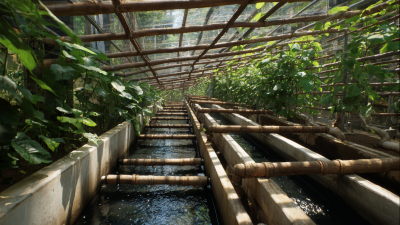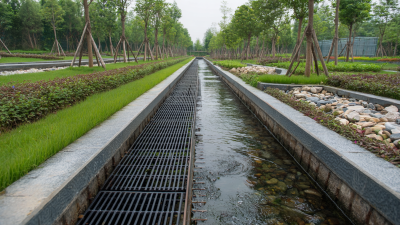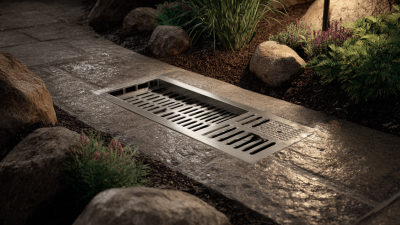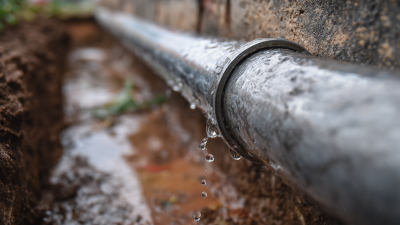When it comes to managing water flow and drainage in construction and landscaping projects, selecting the right materials is crucial for ensuring efficiency and longevity. One of the most essential components in efficient water drainage systems is the perforated drain pipe. As a versatile solution for both residential and commercial applications, perforated drain pipes are designed to effectively alleviate water buildup around foundations, landscapes, and gardens. However, with various options available in terms of size, material, and design, choosing the best perforated drain pipe for your specific project needs can be overwhelming.

This blog aims to guide you through the essential factors to consider when selecting a perforated drain pipe, helping you make an informed decision that will enhance the efficacy of your drainage system. Whether you are a DIY enthusiast or a seasoned contractor, understanding these key aspects will ensure your project's success.
When selecting a perforated drain pipe for your project, several key factors should be taken into consideration to ensure optimal performance. First and foremost, you must assess the specific drainage requirements of your site. Different soil types can significantly impact water flow and retention; hence, the pipe's diameter must align with the anticipated volume of water to be drained. For areas with heavy rainfall or saturated soil, a larger diameter might be necessary to prevent flooding and ensure efficient drainage.
Another important factor is the material of the perforated drain pipe. Common materials include PVC and corrugated polyethylene, each with its own set of advantages. PVC pipes are known for their durability and resistance to corrosion, making them ideal for long-term use. On the other hand, corrugated pipes offer flexibility and ease of installation, which can be beneficial in various project environments. Additionally, consider the spacing and size of the perforations themselves, as these will influence the pipe's ability to absorb and drain water effectively. By evaluating these elements, you can select the best perforated drain pipe that meets your project's unique needs.

When selecting a perforated drain pipe for your project, it's crucial to understand the different types available and their specific uses. Perforated drain pipes are designed to manage water flow effectively and are commonly used in various drainage systems, including French drains, stormwater management, and agricultural applications. The typical types include PVC, Corrugated HDPE, and concrete pipes, each offering distinct advantages depending on the project requirements.
PVC perforated pipes are lightweight and resistant to corrosion, making them ideal for residential and commercial applications where durability is essential. On the other hand, corrugated HDPE pipes are known for their flexibility and ease of installation, which makes them suitable for a variety of terrains and conditions. For more heavy-duty applications, concrete perforated pipes provide immense strength and can handle substantial water loads, often used in municipal stormwater systems. Understanding these differences will ensure that you select the right perforated drain pipe to meet your specific needs, optimizing efficiency and performance in your project.
When selecting a perforated drain pipe for your project, understanding the key features that ensure quality and efficiency is crucial. One significant factor to consider is the material of the pipe. High-density polyethylene (HDPE) is favored for its durability and resistance to corrosion, and studies show it can last over 50 years in appropriate conditions. Additionally, the perforation pattern and size should align with your drainage requirements; a well-designed pattern enhances water flow while preventing soil infiltration.
Tip: Always check the pipe's flow capacity, which is typically measured in gallons per minute (GPM). For instance, a pipe with a larger circumference will effectively handle greater volumes of water, making it essential for projects involving heavy rainfall or runoff.
Moreover, consider the pipe's compatibility with various soil types. According to industry reports, selecting a drain pipe that suits the specific geology of your site can increase efficiency by up to 30%. Are you dealing with sandy, clay, or loamy soil? Each type has different drainage characteristics that affect how the perforated pipe will perform.
Tip: Consult with a drainage specialist to determine the ideal pipe specifications tailored to your soil conditions and anticipated water flow. This proactive approach can significantly enhance the longevity and effectiveness of your drainage system.
When embarking on a drainage project, selecting the right perforated drain pipe is crucial for effective water management. Proper sizing is the first step in ensuring that your drainage system works optimally. Consider the volume of water that typically accumulates in your area, as well as the size and slope of the drain field. The diameter of the pipe should be sufficient to handle the expected flow without causing blockages. Additionally, when installing the drain pipe, it's essential to incorporate a gravel backfill to allow for proper water filtration and to prevent silt from clogging the perforations.
Installation technique also plays a significant role in the performance of your drainage system. Begin with a trench that slopes at least 1% to facilitate proper drainage away from your yard. Lay the perforated pipe in such a way that the holes are facing downward, allowing water to enter while keeping debris out. As highlighted in recent DIY methods for managing surface water run-off, adopting these practices can effectively reduce flooding in lawns and flower beds. By selecting the appropriate size and ensuring correct installation, you can significantly improve your yard’s capacity to deal with heavy rainfall and surface water.
| Pipe Diameter (inches) | Recommended Usage | Drainage Capacity (GPM) | Typical Installation Depth (feet) | Material |
|---|---|---|---|---|
| 4 | Residential French Drains | 20 | 1-2 | PVC |
| 6 | Commercial Drainage Systems | 40 | 3-4 | Corrugated Polyethylene |
| 8 | Agricultural Fields | 70 | 4-6 | PVC |
| 10 | Stormwater Management | 100 | 5-7 | High-Density Polyethylene |
 When selecting perforated drain pipe for your project, it's essential to avoid common pitfalls that can lead to costly mistakes. One frequent error is overlooking the importance of proper sizing. Using a pipe that is either too small or too large can severely affect drainage efficiency. Always assess the volume of water that needs to be drained and choose a pipe with an appropriate diameter to accommodate that flow.
When selecting perforated drain pipe for your project, it's essential to avoid common pitfalls that can lead to costly mistakes. One frequent error is overlooking the importance of proper sizing. Using a pipe that is either too small or too large can severely affect drainage efficiency. Always assess the volume of water that needs to be drained and choose a pipe with an appropriate diameter to accommodate that flow.
Another mistake to watch out for is not considering the type of soil in which the pipe will be placed. Different soil types have varying drainage capabilities, which can impact how well the perforated pipe functions. For instance, clay soils are more compact and retain water, requiring larger or more numerous perforations. Conducting a soil analysis before making your selection can help ensure that you choose the right pipe design.
Lastly, many overlook the importance of pipe material and durability. Not all perforated pipes are created equal; some materials may be prone to corrosion or damage over time. Opt for high-quality materials that are suitable for the specific environmental conditions of your project. Investing in durable options can save you from frequent replacements and maintenance issues down the line.






